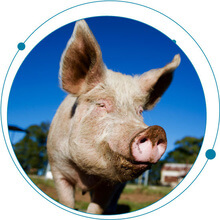 The title says it all. Boar taint is a complex subject. For some, it’s not an issue. Others argue that it’s one of the biggest challenges to pork quality. It’s a very subjective response.
The title says it all. Boar taint is a complex subject. For some, it’s not an issue. Others argue that it’s one of the biggest challenges to pork quality. It’s a very subjective response.
In her blog, Dr. Laura Hancox illustrates the striking difference between the reactions of men and women after sniffing 2 specific pots: one filled with skatole (3-methyl-indole), and one filled with androstenone (5α-androst-16-ene-3-one). These are the 2 compounds of boar taint.
What Hancox experienced and witnessed is consistent with several studies that found that women seem to be more sensitive to boar taint. 1,2 It’s also interesting because studies have also found that about 75% of consumers can detect and taste boar taint.3 Of those consumers, 15 -30% are unable to detect androstenone but seem able to identify skatole.4,5 Clearly, these are pretty good reasons to take boar taint more seriously.
The pork producers’ pain
This is where things get controversial. In efforts to eliminate tainted pork, pork producers usually resort to piglet castration, which raises animal welfare concerns. The European Union is leading the way to seek streamlined alternative solutions to pig castration. The EU Directive 2001/93/EEC, for example, lays down the minimum standards required to protect pig welfare. France and Germany are leading the pack by outlawing the castration of piglets without anesthetic by the end of 2021.
So how does a pork producer prevent tainted boars from entering the fresh food market?
Theoretically, it’s simple: identify tainted carcasses before they are distributed. That means pork producers need to quantify both androstenone and skatole. By doing so, they can remove pigs with unacceptable levels of boar taint at the slaughter line.5
However, the industry struggles to find cost-effective, rapid, validated and standardized methods that can detect boar taint compounds.
Finding the right method
As analytical scientists, we are always looking for cutting-edge and innovative ways to solve our problems with boar taint. Common techniques include:
- Colorimetric method: This is a solvent extraction of fat followed by the addition of a reagent, and then a spectrophotometric fluorescence measurement. It is simple, but the existing online method does not detect androstenone. It also takes up to an hour to analyze 1000 carcasses.5
- Immunoassay: This method is easy to perform but lacks selectivity and antibody specificity. Check out this blog to get an understanding of how mass spectrometry gives you that added edge over immunoassay.
- Gas Chromatography (GC): Although the method is sensitive, sample preparation for GC can be time-consuming. Even when coupled with mass spectrometry, portable GC-MS does not achieve threshold detection of boar taint compounds.
- High-Performance Liquid Chromatography (HPLC): HPLC delivers what we need in an analysis: high sensitivity, high specificity and high reproducibility. It is believed to have a long analysis time.
- Mass Spectrometry (MS): MS offers enhanced specificity of detection and high sensitivity. It can analyze boar taint compounds simultaneously.
Effectively monitor boar taint in 8 steps
How about an 8-step process that takes 8 seconds per analysis? The focus is on speed and accuracy. We have partnered with slaughterhouse industry experts at Phytronix to deliver a robust, rugged and rapid analytical solution for determining boar taint in meat products.
Here are the top 3 key advantages of using a SCIEX mass spectrometer and Laser Diode Thermal Desorption (LDTD):
- Analyze 1 quantitative sample in 8 seconds, that’s up to 700 samples per hour
- Sample only 0.3 grams of fat taken from the back of the animal
- Two parallel analysis production lines that allow you to run 24/7 analysis of skatole and androstenone
Download the fact sheet to find out what makes this 8-step, 8-second process so effective >
References
- Griffiths, Nerys M., and R. L. S. Patterson. “Human Olfactory Responses to 5α-Androst-16-EN-3-One— Principal Component of Boar Taint.” Journal of the Science of Food and Agriculture, vol. 21, no. 1, 1970, pp. 4–6., doi:10.1002/jsfa.740210102
- Xue JL, Dial GD. Raising intact male pigs for meat: Detecting and preventing boar taint. Swine Health and Production. 1997;5(4):151–158
- Vanhonacker, F., and W. Verbeke. “Consumer Response to the Possible Use of a Vaccine Method to Control Boar Taint v. Physical Piglet Castration with Anaesthesia: a Quantitative Study in Four European Countries.” Animal, vol. 5, no. 7, 2011, pp. 1107–1118., doi:10.1017/s1751731111000139
- Wysocki, C. J., and G. K. Beauchamp. “Ability to Smell Androstenone Is Genetically Determined.” Proceedings of the National Academy of Sciences, vol. 81, no. 15, 1984, pp. 4899–4902., doi:10.1073/pnas.81.15.4899
- Hendriks, W H, and M R King. “A Review of the Literature Review on Boar Taint for New Zealand PORK.” pdfs.semanticscholar.org/80d0/a004f8887cef4cb9596ee8c2c1cb35514733.pdf






 Contact Support
Contact Support
0 Comments